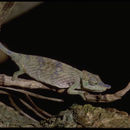Biology
provided by Arkive
Chameleons are generally solitary and move about on slender branches and twigs, gripping with their fused toes. The prehensile tail provides an additional 'hand' on this precarious walkway as they scan the surrounding area with their independently mobile eyes for small insect prey (4). When sleeping or resting, the big-nosed chameleon is said to position itself head downwards as it clings to a narrow twig or vine (3).
In captivity, female big-nosed chameleons have been recorded producing several clutches of two to six eggs each year (3). These eggs are incubated for about 90 days, at a temperature of around 23 degrees Celsius (2) (3).
Conservation
provided by Arkive
The big-nosed chameleon is listed on Appendix II of the Convention on International Trade in Endangered Species (CITES), so that any international trade in this species that does occur should be carefully monitored (1). There are currently no other known conservation measures in place specifically for the big-nosed chameleon, but the government of Madagascar, along with many local and international conservation organisations, are working to conserve the unique biodiversity of this remarkable island (6) (7).
Description
provided by Arkive
One of the smallest of the arboreal chameleons (3), the big-nosed chameleon is named for the large, paddle-like appendage which projects from the nose region (2). This flexible appendage is larger and more square-shaped on males, and is believed to be used to recognise potential mates (2). Male big-nosed chameleons can also be distinguished by the more pronounced casque, a bony head crest (2). The skin of both sexes is usually a shade of brown, reddish-brown, tan, or light green (2) (3), with females not receptive to mating rapidly developing a striking display of whitish-blue to turquoise spots on top of the head and on the sides of the nasal appendage (2). Like other chameleons, this big-nosed species has a prehensile tail, fused toes, distinctive turret-like eyes and an impressively long tongue (4).
Habitat
provided by Arkive
The big-nosed chameleon inhabits primary forest, forest edge and secondary forest where it is found in low vegetation, generally one to two metres above the ground (2).
Range
provided by Arkive
Occurs in the humid regions of eastern and northern Madagascar (2).
Status
provided by Arkive
Listed on Appendix II of CITES (1).
Threats
provided by Arkive
Unlike many other chameleons, the big-nosed chameleon is believed to not be currently threatened by collection for the international pet trade (1); however, other reports indicate that the trade in this species is slowly starting to grow (3). While the big-nosed chamelone has a relatively large distribution, low densities of this species recorded in some areas indicate that certain populations may be at risk from any potential threats (5), such as the habitat destruction impacting many of Madagascar's incredible reptiles (4).

